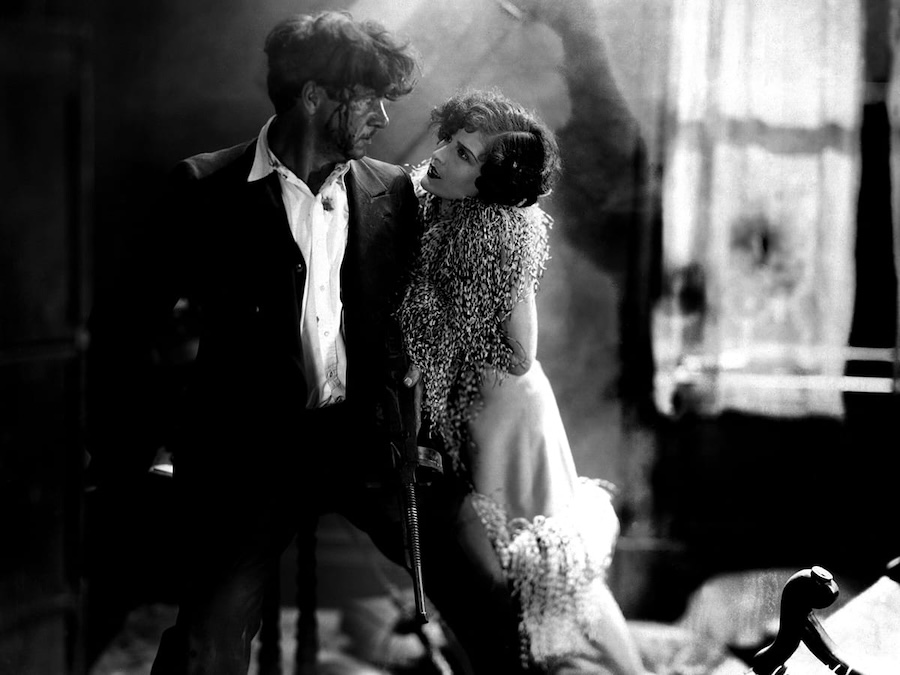
BEASTS OF PREY – LIVING ON THE FRUITS OF OTHER MEN’S LABOR!

In the 1920s, the journalist and author Ben Hecht didn’t care all that much for the movies. Ironic, since his major achievements came to be defined by his work in Hollywood, not really his books. According to Adina Hoffman’s biography ”Ben Hecht: Fighting Words, Moving Pictures”, Hecht came to Tinseltown with no idea of what to write for the movies. Then he looked to his past as a reporter in Chicago and came up with Underworld, writing in a way that was inspired by a friend, the poet Carl Sandburg. What came out of it was the silver screen’s first major gangster movie hit.
Dragging along a bum
The story begins in ”a great city in the dead of night”. That’s when the gangster ”Bull” Weed (George Bancroft) strikes once again. As he makes his escape from a robbery, he drags along a bum (Clive Brook) that he finds on a street corner. He realizes that the man is a drunk, but the bum tells Weed angrily that in any case, he’s ”no squealer”. Over the years, he proves his mettle. ”Rolls Royce” Wensel becomes Weed’s most trusted collaborator, pretty much the brains behind their operation.
He’s a former lawyer who hit hard times, but working with Weed makes him stop drinking. However, he does take an interest in Weed’s girlfriend, ”Feathers” McCoy (Evelyn Brent)… and there’s a dangerous rival, Buck Mulligan (Fred Kohler).
Inspired by Chicago crime reporting
In Chicago, Hecht became one of those hard-drinking reporters that he and Charles MacArthur came to spoof in their 1928 play ”The Front Page”. In his script for Underworld, Hecht let his experiences from covering Chicago’s criminal class color the story; for instance, the character of ”Bull” Weed was reportedly based on ”Terrible” Tommy O’Connor, a cop killer whose escape before execution is mirrored in the film’s second half. Much has been made of Underworld as the beginning of Hollywood’s gangster movies in the era of early talkies. One of those films, Scarface (1932), was incidentally also co-written by Hecht. Others are careful not to make that comparison, since Underworld doesn’t follow the formula of those gangster movies; this isn’t really the rise and fall of a notorious gangster, but a character study involving three people who are tied to each other in their criminal enterprise. But, really, it’s easy to see the similarities. Underwold became a massive hit for pretty much the same reasons as Scarface: it moves fast, it’s violent, there are charismatic hoodlums and the action is explosive.
A great part of the film’s success lies in Josef von Sternberg’s direction. For him, this film was kind of a revenge. He had been hired by Paramount the previous year as an assistant director, after a couple of humiliating experiences. Underworld showed not only Paramount and the audience that he was a force to be reckoned with, but future international filmmakers like Marcel Carné were inspired by von Sternberg’s dynamic and tough portrayal of the Prohibition Era’s world of crime – even if Hecht was displeased with what he thought was von Sternberg’s ”sentimental touch” and wanted his name taken off the credits.
Brook is effective as the man who turns his alcoholism into another obsession.
The story is simple and Bancroft seriously chews the scenery as Weed. But Brook is effective as the man who turns his alcoholism into another obsession, nursing Weed’s criminal career. Larry Semon is also entertaining in one of his last roles as ”Slippy”, sort of a court jester in Weed’s world.
Underworld 1927-U.S. Silent. 80 min. B/W. Directed by Josef von Sternberg. Screenplay: Charles Furthmann, Robert N. Lee. Story: Ben Hecht. Cinematography: Bert Glennon. Editing: E. Lloyd Sheldon. Cast: Clive Brook (”Rolls Royce” Wensel), Evelyn Brent (”Feathers” McCoy), George Bancroft (”Bull” Weed), Fred Kohler, Helen Lynch, Larry Semon.
Trivia: Alternative title: Paying the Penalty.
Oscar: Best Original Story.
Last word: “I had provided the work with many an incident to placate the public, not ignoring the moss-covered themes of love and sacrifice. Human kindness was demonstrated by showing a murderer feeding a hungry kitten.” (von Sternberg, Criterion)
